Refine search
Actions for selected content:
980 results in Applied probability and stochastic networks
9 - Practical object tracking
-
- Book:
- Fundamentals of Object Tracking
- Published online:
- 07 September 2011
- Print publication:
- 28 July 2011, pp 312-343
-
- Chapter
- Export citation
Frontmatter
-
- Book:
- Fundamentals of Object Tracking
- Published online:
- 07 September 2011
- Print publication:
- 28 July 2011, pp i-iv
-
- Chapter
- Export citation
Appendix C - Pseudo-functions in object tracking
-
- Book:
- Fundamentals of Object Tracking
- Published online:
- 07 September 2011
- Print publication:
- 28 July 2011, pp 358-360
-
- Chapter
- Export citation
References
-
- Book:
- Fundamentals of Object Tracking
- Published online:
- 07 September 2011
- Print publication:
- 28 July 2011, pp 361-369
-
- Chapter
- Export citation
5 - Single- and multiple-object tracking in clutter: object-existence-based approach
-
- Book:
- Fundamentals of Object Tracking
- Published online:
- 07 September 2011
- Print publication:
- 28 July 2011, pp 133-222
-
- Chapter
- Export citation
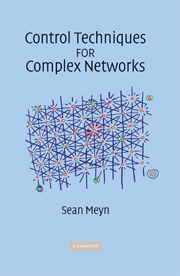
Control Techniques for Complex Networks
-
- Published online:
- 17 March 2011
- Print publication:
- 10 December 2007
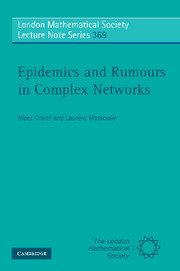
Epidemics and Rumours in Complex Networks
-
- Published online:
- 25 January 2011
- Print publication:
- 03 December 2009
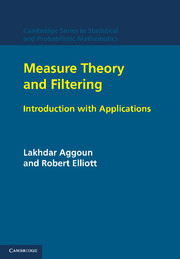
Measure Theory and Filtering
- Introduction and Applications
-
- Published online:
- 06 July 2010
- Print publication:
- 13 September 2004
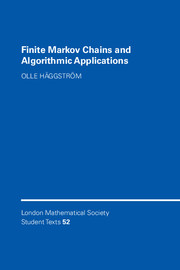
Finite Markov Chains and Algorithmic Applications
-
- Published online:
- 29 March 2010
- Print publication:
- 30 May 2002
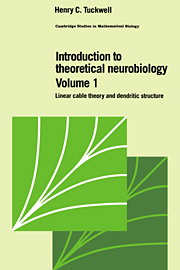
Introduction to Theoretical Neurobiology
-
- Published online:
- 29 December 2009
- Print publication:
- 29 April 1988
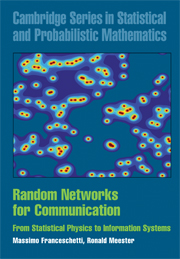
Random Networks for Communication
- From Statistical Physics to Information Systems
-
- Published online:
- 12 December 2009
- Print publication:
- 10 January 2008
References
-
- Book:
- Epidemics and Rumours in Complex Networks
- Published online:
- 25 January 2011
- Print publication:
- 03 December 2009, pp 117-121
-
- Chapter
- Export citation
8 - Epidemics on general graphs
-
- Book:
- Epidemics and Rumours in Complex Networks
- Published online:
- 25 January 2011
- Print publication:
- 03 December 2009, pp 87-107
-
- Chapter
- Export citation
5 - From microscopic to macroscopic dynamics
-
- Book:
- Epidemics and Rumours in Complex Networks
- Published online:
- 25 January 2011
- Print publication:
- 03 December 2009, pp 54-62
-
- Chapter
- Export citation
2 - Reed–Frost epidemics and Erdős–Rényi random graphs
-
- Book:
- Epidemics and Rumours in Complex Networks
- Published online:
- 25 January 2011
- Print publication:
- 03 December 2009, pp 19-34
-
- Chapter
- Export citation
9 - Viral marketing and optimised epidemics
-
- Book:
- Epidemics and Rumours in Complex Networks
- Published online:
- 25 January 2011
- Print publication:
- 03 December 2009, pp 108-116
-
- Chapter
- Export citation
4 - Diameter of Erdős–Rényi graphs
-
- Book:
- Epidemics and Rumours in Complex Networks
- Published online:
- 25 January 2011
- Print publication:
- 03 December 2009, pp 46-53
-
- Chapter
- Export citation
Index
-
- Book:
- Epidemics and Rumours in Complex Networks
- Published online:
- 25 January 2011
- Print publication:
- 03 December 2009, pp 122-123
-
- Chapter
- Export citation
Contents
-
- Book:
- Epidemics and Rumours in Complex Networks
- Published online:
- 25 January 2011
- Print publication:
- 03 December 2009, pp v-vi
-
- Chapter
- Export citation
1 - Galton–Watson branching processes
-
- Book:
- Epidemics and Rumours in Complex Networks
- Published online:
- 25 January 2011
- Print publication:
- 03 December 2009, pp 7-18
-
- Chapter
- Export citation
